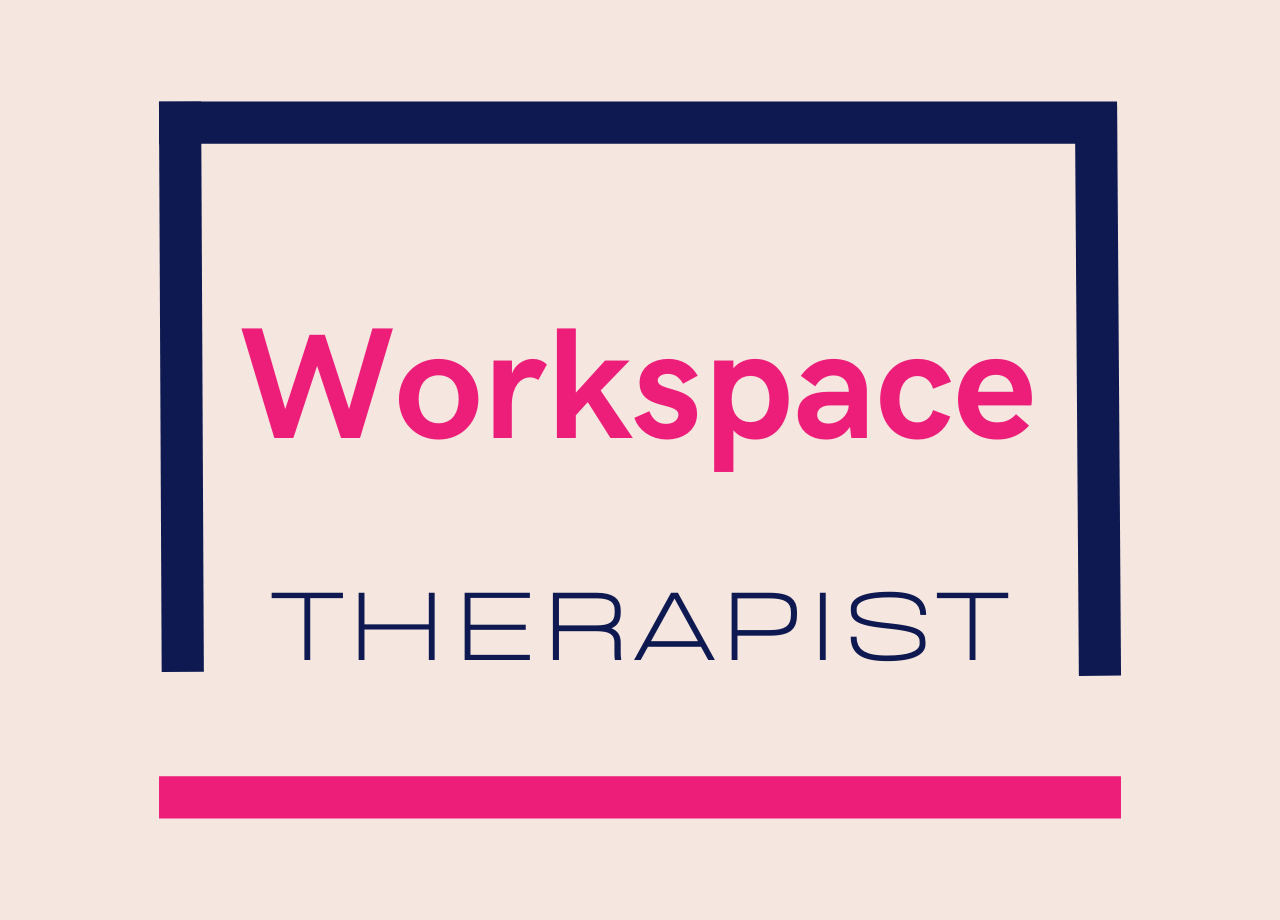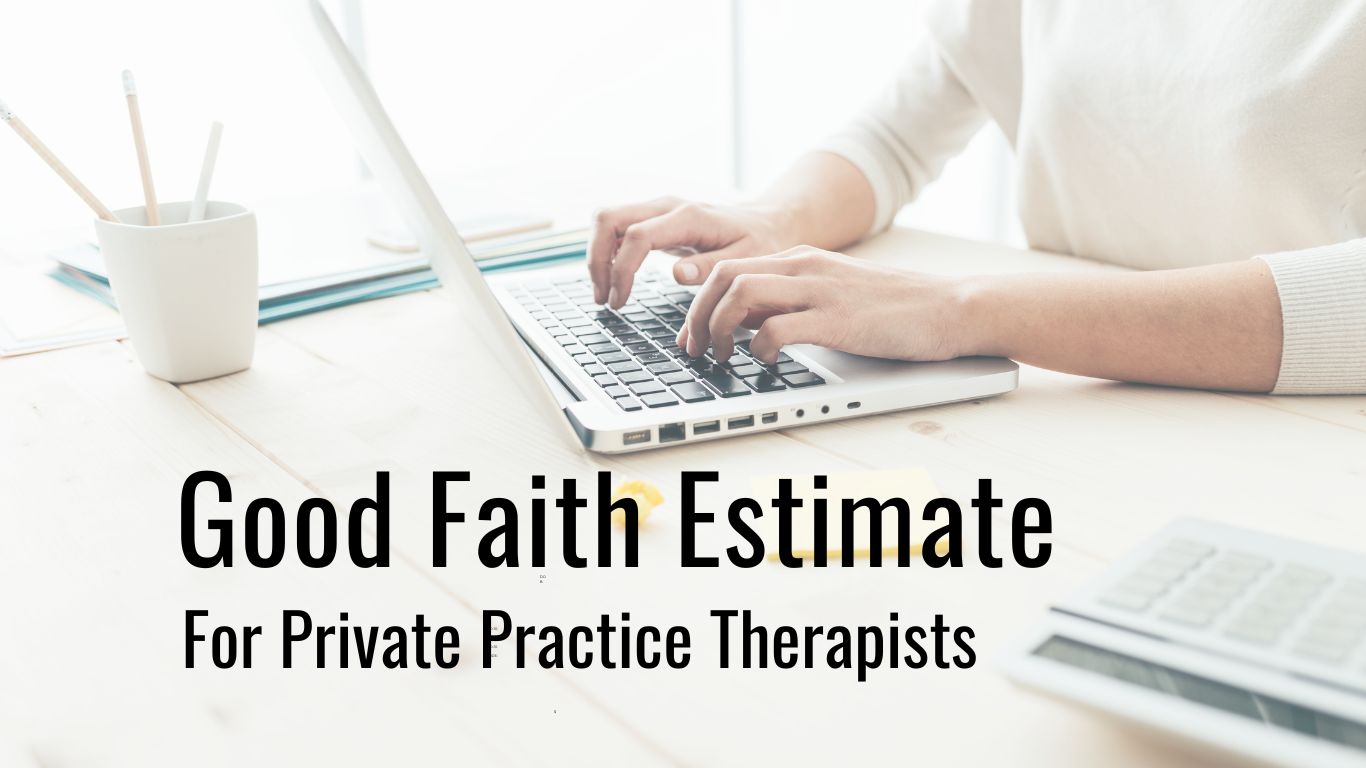A Comprehensive Guide for Private Practice Therapists
Clear and upfront communication about the cost of healthcare treatment isn’t just good business—it’s a legal and ethical commitment that lays the foundation for trust with your patients. With the No Surprises Act in place, providing a detailed Good Faith Estimate (GFE) is now an essential part of every private practice’s toolkit. This document not only ensures compliance but also empowers you to set clear expectations with clients from the very start. Whether your patients are self-paying or choosing not to bill their insurance directly, a well-crafted GFE offers transparency, builds trust, and helps manage evolving treatment plans with confidence. In this post, we’ll explore what a GFE is, why it matters, and how you can create one that meets both regulatory standards and the unique needs of your practice. Plus, I’ll share tips on how to seamlessly integrate this document into your workflow—and share how you can get a customizable Good Faith Estimate template designed just for therapists.
What Is a Good Faith Estimate?
A Good Faith Estimate is your practice’s best judgment of the projected cost of care, based on a patient’s individualized plan. Required by the No Surprises Act which was put into effect in 2022, the GFE is essential for patients who are either self-paying or not directly billing their insurance. Essentially, it’s a transparent forecast that outlines the services you’ll provide, the associated costs and any variables that might affect the final bill.
Why It’s Essential
- Transparency: Clients appreciate knowing what to expect from the outset. A GFE demystifies the billing process and helps prevent misunderstandings down the road.
- Regulatory Compliance: With guidelines set forth by the Department of Health and Human Services (HHS), having a GFE is no longer optional—it’s a required practice that helps shield you from disputes and regulatory issues.
- Flexibility: Recognizing that a plan of care can evolve based on patient progress, adherence, or additional needs, the GFE is designed to be an estimate. This flexibility means you can adjust the estimate as treatment evolves.
Why Private Practice Therapists Need a Good Faith Estimate
Building Trust and Reducing Surprises
When clients walk into your office, they’re looking for both professional expertise and a sense of security. Providing a GFE reassures them that you’re upfront about costs—even when their treatment plan might change over time. Instead of being caught off guard by unexpected charges, clients can review the GFE as a roadmap for their financial investment in care. This proactive transparency goes a long way in building long-term trust and satisfaction.
Streamlining Your Practice’s Operations
A well-prepared Good Faith Estimate is more than just a legal requirement—it’s an administrative tool that simplifies your day-to-day operations. By clearly outlining the expected charges and potential variables, you reduce the likelihood of billing disputes and last-minute questions. This not only saves time for you and your staff but also ensures that every client understands the value of the services they’re receiving.
Enhancing Professionalism and Compliance
Adhering to the guidelines for a GFE demonstrates your commitment to the highest standards of professional practice. With regulatory bodies and professional organizations such as the American Psychological Association and the American Speech-Language-Hearing Association offering free detailed templates and guidance, incorporating a GFE into your practice is simple and shows that you’re dedicated to transparency, ethical billing practices and patient-centered care.
Essential Components of a Good Faith Estimate
Creating a comprehensive GFE means including all the necessary details to both inform your client and comply with legal guidelines. Here are the key elements you should cover:
Client and Provider Information
- Patient Name & Date of Birth: These basic details ensure that the estimate is personalized and directly tied to the individual receiving care.
- Provider Information: Include your name, NPI, tax ID number and the location where services will be provided. This establishes accountability and clarity.
Detailed Service Descriptions
- Description of Services: Clearly outline the services you will provide. This might include therapy sessions, diagnostic testing, or any specialized treatments you offer.
- List of Equipment or Materials: If your services include any equipment or materials—like specialized therapy tools or assistive devices—list these items separately along with their costs.
Billing and Coding Details
- Diagnosis and Procedure Codes: Incorporate relevant ICD-10, CPT, and HCPCS Level II codes where applicable. These codes help standardize the billing process and ensure that the estimate aligns with established rates.
- Itemized Charges: Depending on your practice’s preference, you can list charges per individual procedure code or by visit type (e.g., initial evaluation, follow-up therapy session). This breakdown makes it easier for clients to understand where their money is going.
Payment Terms and Disclaimers
- Payment Terms: Clarify when payments are due and the methods you accept. Are payments expected at the time of service, or is there a billing cycle in place? Detail any payment plans you might offer.
- Disclaimers: Since treatment needs may change, include a disclaimer noting that the GFE is an estimate and may be updated as the treatment plan evolves. Also, specify that if actual costs “significantly exceed” the estimate (more than $400 over per session), a dispute resolution process is available.
- Voluntary Agreement: Reinforce that the patient’s receipt of the GFE does not obligate them to follow the entire treatment plan, ensuring they retain the right to adjust their care decisions.
Timing and Delivery of the Good Faith Estimate
When to Provide the GFE
The optimal time to introduce the GFE is during the initial consultation or intake session or immediately after. This is when you’re establishing rapport and setting expectations for the treatment journey ahead. Providing the GFE right after the initial consultation and prior to the first therapy session not only ensures that your clients are informed from the outset but also aligns with regulatory guidelines.
How to Distribute the GFE
- Digital Distribution: Email or upload the GFE to an online client portal. This method ensures quick delivery and easy access for clients.
- Printed Copies: For clients who prefer a tangible document, provide a printed copy during in-person consultations.
Integrated Systems: If you use a digital practice management system like Google Workspace, you can integrate the GFE directly into your onboarding or scheduling workflow. This seamless integration ensures consistency across all client interactions.
Record Keeping and Follow-Up
Keeping a record of the GFE distribution is crucial. Not only does it protect your practice in case of disputes, but it also helps maintain an organized approach to client management. Document when and how the GFE was delivered and note any client acknowledgments.
Step-by-Step Guide to Creating Your Good Faith Estimate
While the idea of creating a GFE might seem overwhelming, breaking it down into a series of simple steps can make the process much more manageable. Here’s how to get started:
Step 1: Gather All Relevant Information
Before you draft your GFE, collect all the necessary data:
- Service Listings: Prepare a detailed list of all the services you offer.
- Fee Schedules: Update your fee schedule and any sliding scale information.
- Coding Guidelines: Gather the appropriate ICD-10, CPT and HCPCS codes that relate to your services.
- Regulatory Requirements: Review the HHS guidance and your professional organization’s recommendations to ensure your GFE meets current standards.
Step 2: Outline the Document
Structure your GFE in a clear and logical format. A typical outline might include:
- Client and Provider Details: Basic information as described above.
- Service Descriptions and Itemized Charges: Break down each service and associated costs.
- Payment Terms and Disclaimers: Clearly outline the conditions under which the GFE applies.
Additional Notes: Any further details, such as cancellation policies or potential additional fees.
Step 3: Customize and Brand Your GFE
Your GFE should reflect the professionalism and personality of your practice:
- Branding Elements: Use your practice’s logo, colors and fonts to create a cohesive look.
- Clear, Accessible Language: Avoid overly technical jargon. The goal is clarity—your clients should easily understand every section.
- Visual Aids: Consider including tables or bullet points to organize information neatly. Visual aids can help break up text and make the document less intimidating.
Step 4: Review, Update and Get Feedback
Once your GFE is drafted:
- Peer Review: Consider asking a colleague or legal advisor to review it for compliance and clarity.
- Client Feedback: If possible, gather feedback from current clients on how understandable the document is.
- Regular Updates: Treatment plans and fees can change, so make it a habit to review and update your GFE regularly. This ensures that it remains an accurate reflection of your services.
Step 5: Implement and Communicate with Confidence
Introduce your GFE confidently to new clients:
- Personal Walk-Through: During initial consultations, take a few moments to explain the GFE. Answer any questions and highlight how it protects both the client and your practice.
Documentation and Follow-Up: After the initial presentation, follow up with a copy of the GFE and ask clients to acknowledge receipt. This not only reinforces transparency but also builds trust.
Common Questions About the Good Faith Estimate
Frequently Asked Questions
Q: What if treatment needs change during the course of care?
A: It’s important to remember that the GFE is an estimate based on current information. If treatment needs evolve—due to patient progress or additional comorbidities—a new estimate can be requested. This flexibility is built into the process, ensuring that the document remains relevant throughout the course of care.
Q: How detailed should my GFE be?
A: While thoroughness is important, the key is clarity. You don’t need to overwhelm clients with every single detail, but the document should cover the essential components: service descriptions, fee breakdowns, coding information and payment terms. Striking a balance between detail and readability is crucial.
Q: Is the GFE legally binding?
A: No, the GFE is not a legally binding contract. It’s an estimate designed to inform patients of expected costs and outline potential variables. Should actual costs exceed the estimate significantly (more than $400 per session), patients have the right to engage in a dispute resolution process.
Professional GFE Templates
Recognizing the complexities of billing in therapy services, both ASHA and the APA as well as other professional organizations have developed downloadable GFE templates tailored for those professionals. These templates include:
- Standardized Coding Information: Incorporating CPT, HCPCS, and ICD-10 codes to align with established billing practices.
- Customizable Formats: Whether you prefer to list charges per procedure or by visit type (e.g., initial evaluation, ongoing therapy), the templates offer the flexibility to suit your practice’s needs.
- Clear Sample Language: Suggested phrasing and formats help ensure that the document is both comprehensive and easy to understand.
While you may choose not to list every cost per billing code, these templates provide a solid foundation for creating a detailed and compliant GFE. They’re an excellent resource if you’re looking to streamline your process and ensure you’re meeting regulatory requirements. ASHA’s template is here and the CMS.gov template is here.
Implementing Your Good Faith Estimate: Practical Tips for Success
Once your GFE is ready, integrating it into your practice is the next step toward improved client communication and administrative efficiency. Here are some practical tips:
Develop a Standardized Process
- Consistency is Key: Use the same GFE format for every new client to create a predictable and professional experience. Keep a master of the template that you can copy for each client.
- Staff Training: Ensure that all administrative staff understand the purpose of the GFE and are trained to explain its components to clients.
- Digital Integration: If you use an electronic health record (EHR) or practice management system (such as Google Workspace), incorporate the GFE into your client onboarding process. This can be done through email templates or client portal uploads.
Create a Client-Friendly Presentation
- Visual Appeal: Use clean design elements and bullet points to organize information. Consider adding a brief infographic that outlines the GFE process.
- Personal Touch: Take a few moments during initial consultations to walk your clients through the GFE. Explain each section in simple terms and encourage questions.
- Feedback Loop: Invite feedback on the GFE’s clarity. Over time, small adjustments can make a significant difference in client understanding and satisfaction.
Maintain Flexibility and Accuracy
- Regular Reviews: Set a schedule to review and update the GFE. As your practice evolves or as regulatory guidelines change, it’s important that your GFE remains current.
- Document Changes: When updating the GFE, document the changes and inform your existing clients if the revisions affect their treatment plans.
- Dispute Resolution: Clearly outline the process for addressing significant discrepancies between estimated and actual costs. This transparency not only builds trust but also protects your practice from potential conflicts.
Final Thoughts: The Good Faith Estimate in Private Practice
The Good Faith Estimate is more than a regulatory checkbox—it’s a critical tool for ensuring clarity, building trust, and protecting both your clients and your practice. By providing a detailed, transparent forecast of expected costs, you create a solid foundation for open communication and financial predictability.
Remember, the GFE is an evolving document. As treatment plans change, so too can the estimate, reflecting your commitment to personalized care and ethical billing practices. With the right approach and the support of resources like the ASHA or CMS.gov downloadable templates, you can implement a GFE that is as dynamic and responsive as the care you provide.
So, take a deep breath and embrace the process. With careful planning, consistent updates, and a clear presentation, your GFE will not only meet regulatory requirements but also enhance your practice’s reputation for transparency and professionalism. And if you’re looking for a head start, consider checking out my customizable GFE template designed to integrate seamlessly with your practice management system.
In the end, embracing transparency with a well-crafted GFE isn’t just about compliance—it’s about building genuine trust and empowering clients to feel secure in every step of their care journey.
Grab your customizable Good Faith Estimate template 👉 HERE!
Want To Use Google Workspace For EHR In Your Therapy Practice?
Click the button below to access the free mini course and see how Google Workspace can be used to manage your practice!
Click Here



